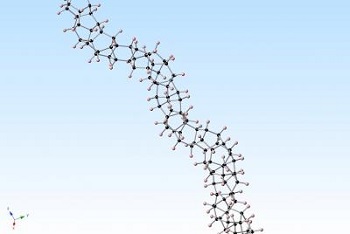A team of researchers at Penn State University have created a new method to produce ultra-thin ‘diamond nanothreads’. This material is expected to possess exceptional stiffness and strength compared to existing high strength polymers and nanotubes.
 Image Credit: John Badding lab, Penn State Univeristy
Image Credit: John Badding lab, Penn State Univeristy
Penn State University chemistry professor John V. Badding led the study and commented that the states that the type of structure formed by the nanothreads had not been observed before.
The nanothread core was composed of a strand of carbon atoms which was similar in structure to diamonds.
The zig-zag rings of six carbon atoms were bound together and every carbon was bounded by other atoms in a tetrahedron shape. The structure was similar to a long miniature necklace with very small diamonds.
Attempts to compress liquid benzene and other separate carbon-containing molecules into a structured diamond-like nanomaterial had so far been unsuccessful. However, the research team at Penn State University successfully compressed benzene, which contains six atoms each of carbon and hydrogen. Sufficient compression was applied at room temperature and then the pressure was released slowly.
This gave carbon atoms enough time to react with one another and form a chain of carbon tetrahedrons in a single-file, creating diamond-core nanothreads. The molecules containing the carbon atoms were initially made to form a tetrahedron shape and then each tetrahedron was linked to form a chain-like diamond nanothread, which was surrounded by hydrogen atoms.
John Badding, professor of chemistry at Penn State, talks about his research.
The scientists used X-ray diffraction, Raman spectroscopy, solid-state nuclear magnetic resonance, transmission electron microscopy and first-principle calculations, in order to validate the structure of the diamond nanothreads.
The high pressures required to produce the diamond nanothread material prevents it from being currently produced on a large scale, although the team at Penn State University hope to develop practical methods for producing diamond nanothreads on an industrial scale soon.
The study suggests that other types of atoms could be attached to carbon and hydrogen cores, in order to create different nanothreads with a range of materials. This discovery has been published in Nature Materials journal.